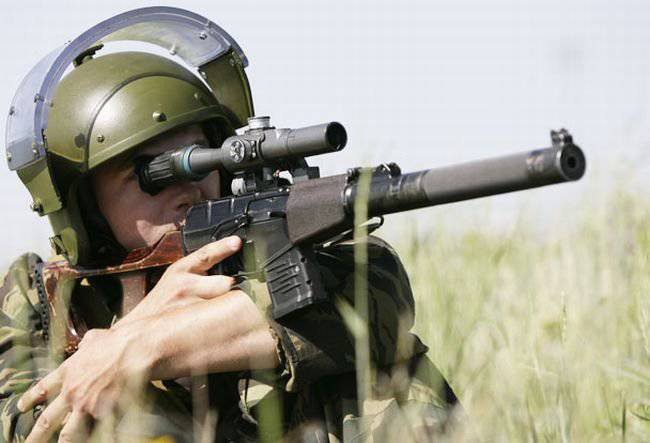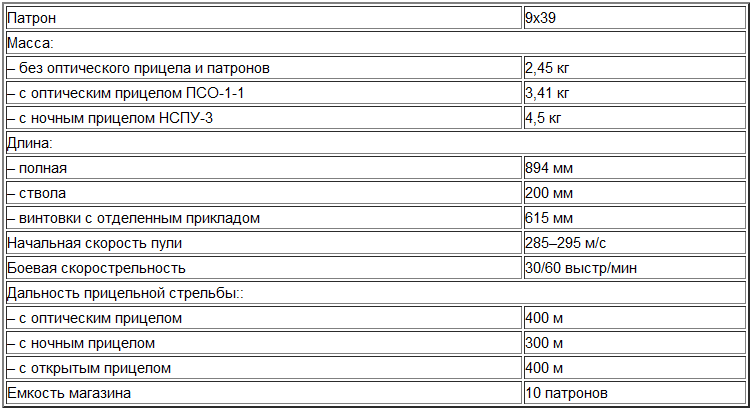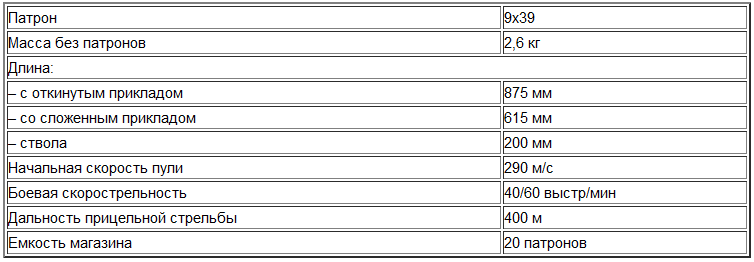Especially for special forces

2012 marks a quarter of a century since the adoption of Soviet 9-mm silent complexes, known mainly for their ciphers, Vintorez and Val. They themselves have long ceased to be secret examples of domestic small weapons and, as they say, become familiar. So somehow forgot how unique these systems are.
Family of silencers
Special forces soldiers know well that they are obliged to fulfill their task at any time, professionally, accurately, quickly and covertly. Of course, they should be able to use any weapon - either of the usual, all-army or police type, or designed specifically for them. Nevertheless, the effective implementation of special tasks requires appropriate weapons.
In the series of special-purpose weapons, the most widely represented are samples with a reduced sound level of the shot - the so-called silent weapon or the weapon of silent and flameless shooting. A completely silent shot cannot be achieved, but if its sound is the same as when shot from a small-caliber sports rifle (130 – 131 dB), this is already a very good result.
As you know, the main sources of the sound of a firearm's shot are powder gases leaving the barrel with high pressure, speed and temperature. Add to this the particles of gunpowder, which burn out after the departure from the bore. As a result, a sharp pressure jump at the muzzle forms a sound wave, which is called a muzzle. A sharp rise and then a pressure drop determines the characteristic sound of the shot.
If the speed of a bullet exceeds the speed of sound, a shock (ballistic) wave is formed when it flies through the air, the front of which is ahead of the bullet and also serves as a source of sharp high-level sound. Accordingly, the most applicable methods for reducing the sound level of a shot are the preliminary expansion, braking and cooling of powder gases to their release into the atmosphere and a decrease in the initial velocity of the bullet below the sound speed.
Almost from the very beginning of the use of silent weapons - that is, for over a hundred years - two main approaches emerged. The first is to supply silent and flameless firing devices (PBS, often just called silencers) to standard samples of ordinary “noisy” weapons - combat, sport or hunting, or use a variant of a regular cartridge with a reduced bullet speed. The second is to develop and manufacture ammunition and weapons completely anew.
The first way is simple and convenient, it has been applied for a long time and widely. In the USSR, at the end of the 30s, the Brahmit muzzle silencer (by the name of the developers, “Mitina Bratya”) went to the troops for a regular trilinear, which was used together with a special rifle cartridge with a reduced charge of gunpowder. Such noiseless “complexes” were widely used during the Great Patriotic War.
Then, a detachable PBS and a 7,62 US assault rifle cartridge with a reduced speed bullet were created for the AK machine gun (the powder charge was reduced three times). On AKM and AKMS installed PBS-1, used with the same US cartridge (at the same time the sight was replaced). In 1985, the shortened AKSB 74U with the PBS-4 device and the 5,45 US cartridge was entered into service (the gunpowder charge was reduced more than fivefold compared to the conventional 5,45X39 automatic gun cartridge).
All over again
These CBEs work quite effectively and are widely used in special forces units. However, base samples of weapons and ammunition are usually created without taking into account the requirements of silent shooting. And the size and weight of weapons muzzle CBE increase very noticeable.
A new step in the development of silent weapons was the development of the “cartridge-weapon” complex, which more fully meets the special requirements of the special forces. This is a silent sniper (BSC) and assault rifle (LHC) complexes with an integrated silencer, designed in the 80-ies at the Central Scientific Research Institute of Precision Engineering in Klimovsk near Moscow.
The integrated silencer, which forms a single whole with the barrel of a weapon, made a good showing during the Second World War and after its completion. It is enough to recall British products - the Velrod pistol, the De Lizl Commando carbine, the Sterling L34А1 submachine gun, the German ones - Heckler und Koch M5 SD, Soviet PB and APB pistols, etc. All these samples were carried out under pistol cartridges . But TsNIITOCHMASH presented fundamentally new complexes for special automatic-type cartridges with an increased bullet striking effect. Silent weapons in any case, working at close distances (subsonic initial speed of the bullet severely limits the range of aimed fire), but the bullet had to reliably hit a living target in the means of individual armor.
The silent sniper complex was created by P.I. Serdyukov and V.F. Krasnikov, it was put into service in 1987 year. The BSC includes the BCC rifle itself (that is, the special sniper, the Vintorez cipher, the GRAU index 6P29) and the sniper 9-mm special cartridge SP5. Two years later, an automaton complex was put into service, including an AS (special automaton, Val code, 6P30 index) and SP6 cartridge. Within the framework of the new “family,” a high level of unification was achieved - 70 percent of the parts and assemblies of the BCC rifle and the AU machine gun are interchangeable, the similarity of the ballistics of the bullets of SP5 and SP6 cartridges allows them to fire from both types of weapons on a single sight.

The sniper cartridge SP5 was created by N. V. Zabelin and L. S. Dvoryaninova on the basis of the cartridge case of an automatic cartridge of the model 1943 of the year. An increase in the caliber of up to nine millimeters made it possible, at a subsonic initial speed, to provide a bullet — by increasing its mass to 16,0 – 16,2 grams and lateral loads to 24 g / cm2 — resistance to trajectory, good accuracy, high piercing and slaughter effect. The SP5 bullet has a bimetallic shell inside which there is a steel core in the head part, the cavity behind it is filled with lead. The form of a heavy pointed bullet with a conical narrowing in the tail section gives it good ballistic properties at subsonic speeds.
The recoil momentum of the cartridge type 9х39 is equal to 0,54 kgf. For comparison, the same indicator for the 7,62x39 type cartridge is 0,78 kgf, for the 5,45х39 cartridge cartridge it is 0,49 kgf, and for the 7,62 DC cartridge 0,5 kgf. That is, an increase in the caliber and the weighting of the bullet were not accompanied by a significant increase in the recoil momentum.
The weapon itself has an automatic with a gas engine with the removal of powder gases from the barrel and a long stroke of the gas piston rigidly connected with the bolt carrier. The barrel is locked by turning the bolt, six lugs of which engage with the cut-outs of the receiver. With such a number of lugs, a symmetric distribution of the force is ensured, the shutter, when unlocked and locked, requires a smaller angle of rotation around its axis than with two lugs. The receiver - milled steel, which gives it greater rigidity compared to the stamped box, familiar to combat machines.
Impact mechanism - shock type, with a light drummer. The hammer spring is located below the return spring behind the bolt. The trigger mechanism includes a flag non-automatic fuse. A separate type fire interpreter is placed inside the trigger guard behind the trigger, its right position corresponds to a single fire, the left one to an automatic one. The weapon is distinguished by relatively quiet operation of the automation and trigger mechanism.
Relatively mildly perceived recoil and the movement of a small mass during the operation of the percussion mechanism contribute to the accuracy of shooting.
Powder gases are discharged into the integrated silencer through the holes made along the bottom of the rifling in the walls of the relatively short barrel (in front of the venting hole) and through the muzzle of the barrel. When fired as the bullet moves through the bore, powder gases pass into the muffler cylinder. Before the muzzle cut of the barrel in the cylinder is placed a separator. The end covers and the inclined partitions of the separator have holes along the muffler axis for the passage of the bullet. The bullet passes through the holes, without touching the covers and partitions, and the powder gases, hitting them, change direction, lose speed and temperature. Thus, the integrated silencer does not contain fast-wearing parts.
The sound level of the BCC shot is 130 dB, that is, it does not exceed that very sporting small-caliber rifle (the sound level of the shot from the AKMS automatic rifle with PBS-1 and the 7,62 CSS chuck) is 134 dB.
An open sector sight and a front sight are mounted on the silencer. The silencer is easily separated from the weapon and disassembled for cleaning (firing from a weapon with the silencer removed is not allowed).
The sniper rifle is equipped with a permanent wooden butt of a frame with an elastic nape and a short plastic forearm. The shop is box-shaped, with a plastic case and a staggered arrangement of ten rounds.


On the left wall of the receiver is a bar for installing optical or night sights. The VSS is equipped with an optical sight PSO-1-1, similar to the SVD-1 sight of a SVD sniper rifle, but with distance scales for the ballistics of SP5 and SP6 cartridges. More modern modification of the optical sight - PSO-1М2-01. Of the night sights can be used NSPU-3, 1PN75, 1PN93-1 "Magnus", MBNP-18 (VSSN rifle). Moreover, the used sight may depend on the "department" to which the special unit belongs: not all, taken by the FSB or the Ministry of Internal Affairs, taken by the army. When firing from VSS with single shots at a distance of 400 meters, the diameter of the dispersion of a series of ten shots from the SP5 cartridge should not exceed 11 centimeters.
For concealed carrying, the rifle can be easily disassembled into large parts: a silencer, a butt, a receiver with a barrel and a trigger mechanism.
The cartridge SP6 designed by Yu. S. Frolov and E. S. Kornilova is equipped with an armor-piercing bullet. The steel heat-treated core is longer than that of SP5, with its nose part protrudes from the shell, the space between the core and the bimetallic shell is filled with a lead shirt. The bullet length increased in comparison with SP5 allowed maintaining the same mass and lateral load. The SP6 cartridge with slightly worse accuracy allows to hit live targets at distances up to 400 meters protected by 2 – 3 class bulletproof vest (according to the current GOST) and armored helmet, or unarmored equipment - a bullet pierces 4-mm steel sheet.
The machine has a left-sided skeleton-shaped metal butt of steel tubes, a plastic pistol grip handle, and is nominally used with a magazine with a capacity of 20 cartridges, although 10- and 20-local stores are interchangeable. On the left wall of the receiver machine has a bar for mounting the same optical and night sights.
To understand how compact the 9-mm silent automatic speaker turned out to be, compare it with the 5,45-mm AKSB 74U mentioned above, which, with PBS-4 installed and without a magazine, weighs 3,1 kilograms, has a length of millimeters 860 butt folded, and 630 millimeters folded with . Moreover, as for the accuracy of shooting, and for the striking action of the bullet AKSB 74U noticeably inferior to the AU.
The BCC production and the AU for delivery to special forces units of several power departments were organized at the Tula Arms Plant, the SP5 and SP6 cartridges - at the Klimovsky Stamping Plant. The cost of such complexes, of course, higher than the mass, "linear" military weapons. But for samples that uses special forces, it is inevitable.
Service passage
The complexes turned out to be more than claimed not only in the army reconnaissance and sabotage units, but also in the special forces of law enforcement agencies. Particularly effective compact "Vintorezy" and "Shafts" when conducting special operations in populated areas. Reducing the noise level not only allows you to secretly use weapons, but also reduces the acoustic load on the shooter; it does not interfere with voice communication if the fight is going on in cramped rooms, underground structures, etc. The low-speed bullet is less prone to rebound.
The "family" of the BCC-AS in 90-e was supplemented by the "noisy" automatic machine CP3 ("Whirlwind"), then - CP3М, which were already mentioned earlier. But this weapon is of a different purpose.
Complexes BSK and BAK "revealed" at the beginning of 90-x, and in a somewhat unexpected way. They were not only represented at exhibitions and demonstration exercises, which is completely normal. Fighters of law enforcement agencies with the BCC or AU in their hands were on duty at public events, they were patrolling the streets - the meaning of such a “demonstration” was not very clear.
But much more important combat use of the complexes continued. Due to the increased need for cartridges of type 9x39 SP5 and SP6. The design office of automated lines at the beginning of 2000-s has developed more technological options - sniper 7Н9 with a bullet of increased penetrability and armor-piercing 7Н12. Production of new cartridges of type 9х39 has been mastered at the Tula Cartridge Plant.
Same darling
The interesting solutions offered by domestic gunsmiths - the creators of "Vintoreza" and "Vala" are at least indicated by the fact that the American firm "Grendel", which is actively engaged in the design and production of special-purpose weapons, created the S-16 silent sniper rifle entities along the same path.
To begin with, the ocean developed its own special cartridge 7,62x36 "Grendel" based on the automatic 5,56x45 - the sleeve is shortened, its dultz expanded, a heavy bullet of large elongation 14,3 gram is inserted into it, respectively, the powder charge is reduced. With a barrel length of 409 millimeters, the initial speed of the bullet is "at the limit" - just below 330 m / s. The rifle itself is equipped with an integrated silencer. Here the barrel, the receiver and the integrated two-chamber silencer are specially made, the other nodes are borrowed from the M16 standard rifle. Whether known in the USA about the Russian silent complexes had an effect here is not known.

Information